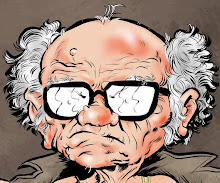Shop Talk: Inking
Inking is probably the most nerve-wracking step in making comics. It is certainly the easiest to mess up. I can’t really offer much advice since I’m still learning the ropes. An excellent inking tutorial can be found here:
http://www.tomrichmond.com/blog/?p=181.
Tom Richmond is an artist for MAD and his tutorials are priceless to beginners. What I can do is talk about the tools I use. I always love to hear what others are using, so here is my contribution.
I primarily use a brush, specifically the Windsor and Newton Series 7 #2. This is the timeless workhorse of inking. Everyone from Will Eisner to Mike Allred used this brush. That said, it takes quite a long time to master, literally around one or two years. But it’s worth it. No other instrument can give such a wide range of lines. They cost about $20 but they last for months, if cleaned properly.
Be warned; your first attempts at inking with this brush will look like shit. You must fight through this at all costs. Do not be discouraged. Things will get better as you go and your improvements will encourage you forward.
I wimped out in the beginning and bought a #00 instead of the #2. It is easier to control but cannot produce the thick, juicy lines of the #2.
Be sure to thoroughly wash the brush if you stop inking for any amount of time. Rinse it in the sink and use hand soap in the middle of your palm to get all the ink out. Scrape dry ink with your finger nail and make sure the brush dries to a point; a brush that can no longer hold a point is only good for inking large areas of black.
To successfully use a brush, you have to separate it in your mind from the act of drawing with a pencil. You must use strong, confident strokes, by locking your wrist and moving your whole arm. Any hesitation will show. Move the paper around to make sure you are inking in the right direction. Keep a jar water on hand to dip the brush if it gets clogged. The same goes for dip pens.
PENS.
Once in a while, I like to use a dip pens for different textures. I use a Hunt/Speedball #102 for fine lines and a #108 for bigger strokes. Pens are much easier to clean and pretty cheap. Be sure to only dip the pen nib halfway into the ink. Too much ink in the nib will clog it. Play it cool.
Many artists these days are using markers. Guys like Frank Cho and Mike Mignola have done pretty well for themselves by skipping the hassles associated with dip pens and brushes. Cho uses the Micron pigma pens, sizes .03, .05. and .07. I tried using these, but found they fade under too much erasing. I prefer the Faber-Castell line of pens. They look more like pen and ink and also have a really cool brush pen available. Using a pen or marker is essential when using a circle or oval template.
INK
I primarily use Speedball Super Black. It is the blackest you can get but can also get pretty thick, and that means clogs. I mix it with a little Hunt Black Magic to soften it up. I haven’t quite found the perfect mixture yet.
WHITE OUT
You will have to fix mistakes occasionally. I use Windsor & Newton’s permanent white gauche. You mix it with a little bit of water and get a nice, fluid white that is easy to ink over.
PHOTOSHOP
This is the best way to calm your frayed nerves about inking. No more permanent mistakes staring you in the face every time you look at a page. More artists are skipping the inking stage by scanning in their pencils and digitally inking in Photoshop. This can be convenient, as well as problematic.
The first problem is price. The program is expensive and the peripherals even more so. You have to get a computer loaded with RAM, and a stylus and a tablet. The most popular is the Wacom tablet. The whole set-up can cost $3000 to $4000. Is it worth it, verses the cost of a brush and ink?
Another problem is the lack of inked original art to sell. This is a big part of a comic artist’s income. That ink is worth a lot more to collectors.
You still have to master the basic skills of inking, regardless of your method. I’d rather work the old fashioned way. I’ll switch over once the millions come pouring in.
BOOKS
The DC Guide to Inking Comics by Klaus Janson
Making Comics by Scott McCloud
Labels: Inking









0 Comments:
Post a Comment
Subscribe to Post Comments [Atom]
<< Home